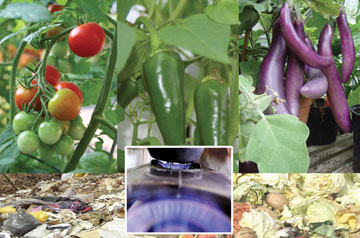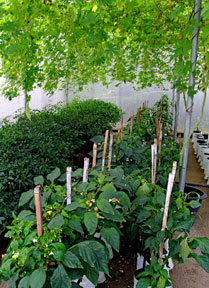|
Awareness on effective use of biogas lacking:
Biogas plants for domestic and industrial use
By Naalir Jamaldeen
The Central Environment Authority (CEA) is taking steps to protect
the environment from contamination and pollution. It insists that large,
medium and small scale industries set up waste water management systems
in factory premises. This decision comes in the wake of environment
activists urging the authorities to minimise pollution.
 |
| |
 |
|
A biogas plant at Dixon,
Ratnapura |
Producing biogas using household waste is also recommended. This
project has been introduced targetting the rural community and will help
prevent the disposal of household waste to the environment and will be a
source of income for them. Srimal Tissera, a resident of Maharagama has
introduced this project in various parts of the country.
Protecting the environment from contamination is the need of the
hour, because a large number of factories are being set up across the
country. Biogas is a mixture of gases produced by the breakdown of
organic matter in the absence of oxygen. Biogas can be produced from
regionally available raw materials such as recycled waste. It is a
renewable energy source and in many cases exerts a very small carbon
footprint.
Biogas is produced by anaerobic digestion with anaerobic bacteria or
fermentation of biodegradable materials such as manure, sewage,
municipal waste, green waste, plant material and crops, he said.
Tissera said that he faced many challenges in the process of
utilising household waste to produce biogas. Even though such a project
was introduced in the 1960s, due to the lack of proper awareness
campaigns the project ended in failure. Bringing this technology to
villages was a challenge, because the people had very little knowledge
about the benefits of such a project. Over 90 percent of projects
failed. Such projects will play a pivotal role in the economy of village
communities, he said.
Producing biogas using household waste is an easy task, whoever is
willing to start this project can easily commence it because very little
capital is required. Plastic water tanks are used in the production
process. Its durability however is comparatively low. Now a well-known
plastic manufacturing firm handles it effectively, he said.
They producing the required materials to produce biogas. It is
somewhat expensive. A 500 litre water tank is enough to produce a biogas
plant, he said.
Pan Asia Bank and the Regional Development Bank has come forward to
help the project. They have arranged loan schemes for those engaged in
biogas production.
The next challenge is to create awareness about this project. Tea
sediment, food waste, vegetable waste and coconut sediments are the raw
materials required to produce biogas, Tissera said.
 |
|
A vegetable cultivation |
This projects are presently in operation in Trincomalee, Batticaloa,
Matara, Colombo, Kalutara, Gampaha, Chilaw and Puttalam areas, he said.
Even the people who live below the poverty line can start this project.
He said that as waste gathers in domestic use is not disposed to the
environment and such a system ensures protection of the environment.
"I introduced a Quality Waste Water Management System at the National
Livestock Development Board in Welisara. A waste water treatment plant
has now been set up in the premises.
 |
|
Srimal Tissera |
"Our people are capable of carrying such projects. This project is a
result of a six- year research", Tissera said.
Liquid fertiliser produced during the biogas production process can
be used even for agriculture. Because this is 100 percent organic
fertiliser. Harvest can be increased by double fold. Gas or liquid
fertiliser can be produced from household waste, he said.
"I have a an idea to produce biogas cylinders. This project is to be
carried out with the help of the Army. We have set up a biogas plant at
the Panagoda Army Camp and we have an idea to set up such a plant at the
Boossa Army Camp",he said.
"We installed a plant last week at the Local Government and
Provincial Council Ministry in Union place. We have set up industrial
level biogas plants at the Ragama hospital and Ceylon Electricity Board
Training Centre in Piliyandala. By December 31, 2012 I could produce 9
million units worth Rs. 90 million of biogas fertiliser.
We have set up a 5,000 litre biogas plant at Temple Trees with the
capacity of five cbm. Two kilos of gas is produced from it. Fifty litres
of active liquid compost fertiliser is produced per day. This fertiliser
is used for vegetable cultivation in Temple Trees. Twenty five kilos of
waste is used in the biogas production process. Waste is a resource for
everyone if they installed this kind of plant",Tissera said.
When asked whether he had an idea to expand this project to other
Government institutions. He said that he has held discussions with
various Government Institutions in this regard.
Pan Asia Bank has introduced a loan scheme for armed forces retirees
and pensioners to operate this kind of project. Regional Development
Banks are ready to help those willing to start such projects. If other
banks also come forward it will be helpful to promote this industry.
Compared to LP gas dangers arising by using biogas is low, he said.
"I have developed a compact biogas plant using waste food rather than
cow dung to produce biogas for cooking.
The plant is compact and can be used by urban households, rural
households, hotels, hospitals, schools, Wild Life Park bungalows, the
Army, Navy, Air Force and Police Camps and Quarters.
Fatty, starchy or sugary feedstock ( kitchen waste, coconut refuse,
market waste, garden waste, hotel waste, paper pulp, water hyacinth
(Japan Gabra, Salvenia). Just 2 kg of such feedstock will produces about
200-250g of methane and the reaction can be completed within 6
hours',Tissera said.
"Biogas plants are environment- friendly, natural, organic-based,
long-lasting and therefore it will be an asset to any organisation or
household. In addition to Biogas, it also produces an Active Liquid
Compost Fertilizer. I have obtained a patent for it. I am also proud to
mention that I have won a Presidential award", he said.
I have come to an agreement with a well-known plastic tank
manufacturer, permitting them to manufacture and market the plant, while
the biogas generation technology is mine . The portable biogas plants
are manufactured to the highest standards by this institution", he said.
Manufacture of a biogas plant requires three times more raw material
than the raw material needed for a normal water tank of the same size.
While the price paid to purchase a plant can be recovered in 14 months
from the generated biogas, the active liquid compact fertiliser produced
by this plant will also be an asset as it helps produce poison-free
crops or vegetables, he said.
"I charge only a nominal consultation fee to make the plants more
affordable. Several local banks are working towards introducing a
low-interest loan scheme for those interested in buying biogas plants",
he said. Biogas has many advantages ,
production of biogas reduces the use of LP Gas and , reduces use of
artificial fertiliser. It also reduces the use of insecticide, he said.
The major advantages of this plant is that it does not require animal
waste to sustain biogas generation and as a result leaves a very small
carbon footprint, which makes it ideal for the installation of such
plants in urban areas. Other advantages are, user friendly, allowing the
users themselves to install the unit according to a set of simple
instructions and, in addition, the users get a highly effective, both as
a fertiliser and an insecticide, liquid organic fertilizer as a
by-product' he said.
The installed plants are now functional and the users have recovered
the installation cost, he said. |

